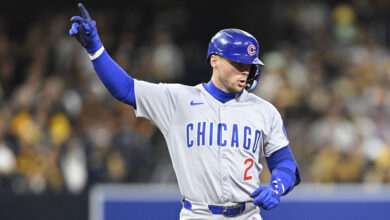
Kyle Hendricks 6 Weeks into Throwing Program, Sounds Like April Is Optimistic Target for Return
Kyle Hendricks is coming off the worst season of his career, which immediately followed what had been his worst season, and he’s entering the final year of his contract with a good deal of uncertainty. While the capsular tear in his right shoulder that ended his season in early July hasn’t required surgery, there’s no guarantee he won’t require a corrective procedure in the future. What’s more, he’s working to adjust his mechanics in an attempt to both shorten his arm path and generate more velocity.
After taking nearly five months off from throwing, Hendricks was finally able to initiate his offseason throwing program on December 1 and has gotten out to 90 feet on long toss. He has yet to get on a mound or throw different pitches, however, and he may not do so until late February or early March. That more or less eliminates the possibility of being ready for Opening Day and could mean he’s out for the first month of the season or more.
“I want to be there as soon as I can,” Hendricks told reporters at Cubs Convention. “Hopefully I’ll be there sometime in April but I’m just gonna take it day by day. I’ll see once I get off that mound and see how it goes and see how much they want me to build up.
“There’s a lot of factors that go into it. I’m just trying to stay healthy and enjoy the throwing and have fun again.”
One of those factors is a mechanical adjustment Hendricks devised with members of the pitching infrastructure. He’s been out in Arizona for a while now as he works to repattern a motion that had gotten a little too long over the years. Changes that are probably imperceptible to the naked eye ended up putting stress on his shoulder, so now he’s got to develop a new arm path that allows for improved health and performance.
“It feels drastic to me yet it might look subtle,” Hendricks shared. “I don’t want to get too short because that’s kind of too far the opposite way. So it’s more making sure I get the ball out of my glove and stay long enough but then just get it right up to my ear. That’s really where my strong position is anyway.
“I can tell how healthy I feel and how good my shoulder feels when I do it the right way.”
A lot has been made about the notoriously soft-tossing righty implementing a Driveline-inspired program most often associated with pitchers trying to make big velo increases, but it’s probably too much to expect more than 90 mph. Instead, Hendricks is trying to build up stength in his shoulder and get back to a point where he’s able to execute properly.
“The hope is to make everything sharper again,” Hendricks explained. “…Basically I just want to make sure I have full extension again, I’m finishing all my pitches and that’s where my good action’s gonna come from and hopefully get a lot of soft contact.”
Again, we’re talking about the slightest difference in release point or spin that results in a pitch moving just a fraction of an inch more and thus avoiding big hits. Hendricks’ most obvious issue over the last two seasons has been homers, which came at a much higher rate due to a sharp increase in barrels and decrease in grounders. After establishing a career-worst 5.2% barrel rate in 2018, Hendricks ballooned to 8.4% in ’21 and 9.9% last season.
For the sake of context, the league average was 7.7% over those two years. While a number of elements influenced Hendricks’ subpar results, one culprit was a decrease in the velo separation between his fastball and changeup. As his fastball dipped to averages of 87.3 and 86.7 mph over the past two campaigns, his change actually increased to 80.1 and 80.0 mph. It’s just those tiny changes that can mean the difference between a harmless grounder to second and the second home run he allowed in an inning landing 20 rows deep in the bleachers.
In addition to his coaches and trainers giving him a boost, Hendricks was clearly energized by being around his teammates. The new guys in particular had him amped up, in part because they’re experiencing CubsCon for the first time and coming to the table with different perspectives. That group includes Tucker Barnhart and Jameson Taillon, who have already started the bonding process now that they’re back in the NL Central.
“I’m so excited to learn from these guys, pick their brains,” Hendricks said. “Especially Jameson and Tucker, having them now with the staff is just gonna sure [sic] us up and I can’t wait to see what we can do.”
That makes at least two of us.

